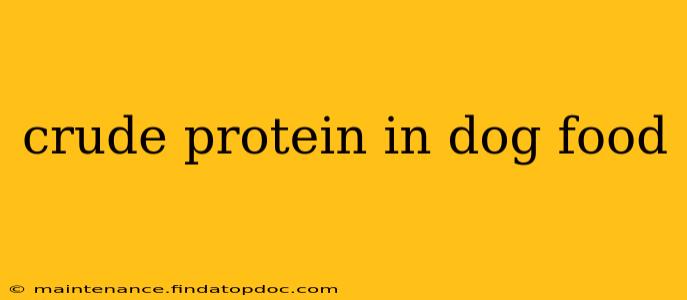Choosing the right dog food can feel overwhelming, with countless brands and formulations vying for your attention. One of the most crucial factors to consider is the crude protein content. Understanding what crude protein is, how it's measured, and its importance for your canine companion's health is key to making informed decisions. This comprehensive guide will unravel the mysteries of crude protein in dog food, answering your burning questions and helping you select the best food for your furry friend.
What is Crude Protein in Dog Food?
Crude protein isn't a direct measure of the digestible protein in your dog's food. Instead, it represents the total amount of nitrogen in the food, multiplied by a factor (6.25) to estimate the protein content. This calculation assumes that approximately 16% of protein is nitrogen. However, this is a simplification, as the nitrogen can originate from non-protein sources like urea or nitrates. This means the "crude" part of the name highlights the fact that it's an approximation, not a precise measurement of the actual digestible protein.
How is Crude Protein Measured?
The measurement of crude protein relies on a laboratory analysis called the Kjeldahl method. This method determines the total nitrogen content in the food sample. The resulting nitrogen value is then multiplied by the conversion factor (6.25) to arrive at the crude protein percentage listed on the food label. It's important to remember that this method doesn't distinguish between digestible and indigestible protein sources. Some components contributing to the nitrogen reading might not be easily utilized by your dog's body.
What Percentage of Crude Protein Does My Dog Need?
The ideal crude protein percentage in dog food varies significantly depending on your dog's age, breed, activity level, and overall health. Generally:
- Puppies: Require higher protein levels (22-30%) for growth and development.
- Adult dogs: Need moderate protein levels (18-22%), depending on activity level. Highly active dogs might benefit from slightly higher levels.
- Senior dogs: May require slightly lower protein levels (15-18%) depending on their kidney function. Always consult your veterinarian.
- Working dogs or highly active breeds: Often benefit from higher protein levels to support their energy demands.
It's crucial to consult your veterinarian to determine the appropriate protein level for your individual dog. They can consider their specific needs and health status to recommend the optimal protein intake.
Is Higher Crude Protein Always Better?
No, a higher crude protein percentage doesn't automatically equate to better nutrition. While protein is essential, excessive protein can strain the kidneys, particularly in senior dogs. The quality of the protein source is equally, if not more, important than the quantity. Look for dog foods that list specific, high-quality protein sources like chicken, beef, lamb, or fish, rather than just "meat by-products."
What are the Consequences of Too Much or Too Little Protein?
Too much protein: Can lead to kidney problems, obesity, and digestive upset.
Too little protein: Can result in weight loss, muscle weakness, poor coat condition, and impaired immune function. Growth stunting can also occur in puppies.
What are the Best Sources of Protein in Dog Food?
High-quality protein sources are crucial. Look for dog foods that prominently list named meat sources (chicken, beef, lamb, fish) as the primary ingredients. Avoid those with vague terms like "meat by-products" or "animal digest," which can be less digestible and of lower nutritional value.
How Can I Choose a Dog Food with the Right Protein Content?
Carefully examine the ingredient list and nutritional information panel on the dog food packaging. Consider your dog's age, breed, activity level, and any specific health concerns. Consult your veterinarian for personalized recommendations on the appropriate protein level for your dog.
Can I Supplement My Dog's Diet with Extra Protein?
Never supplement your dog's diet with extra protein without consulting your veterinarian first. Adding extra protein without considering your dog's overall nutritional needs and health status can be harmful. Your vet can help determine if a protein supplement is appropriate and, if so, recommend the correct type and amount.
By carefully considering the information presented in this guide and consulting your veterinarian, you can make informed decisions about your dog's nutrition and ensure they receive the optimal amount of protein for a healthy and happy life. Remember, the key is balance and choosing high-quality ingredients.
